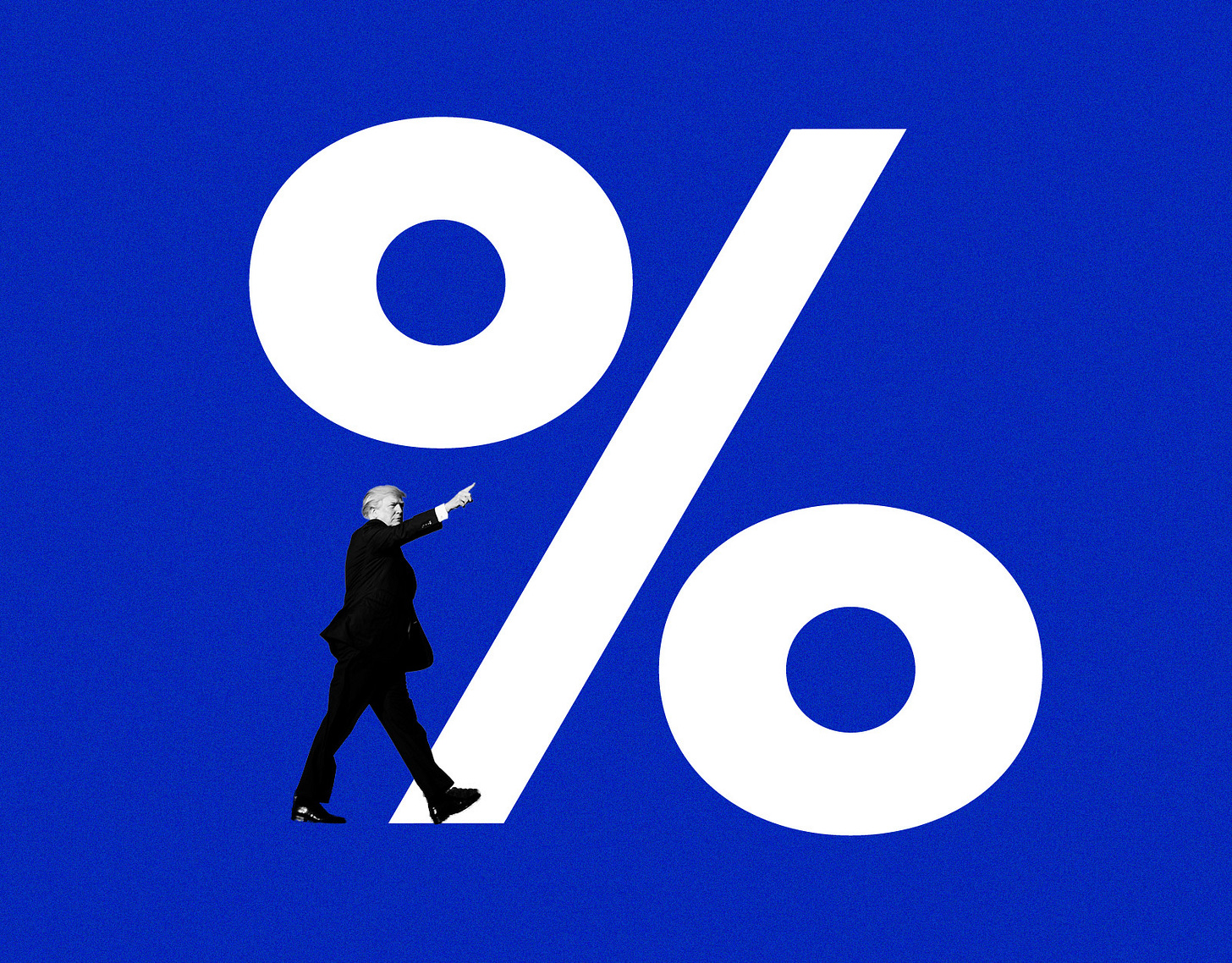
1. Campaign Numerology
This is the point on the ride where everyone freaks out and decides that the polls must be wrong. That you can’t trust the numbers. That something real is happening that isn’t being captured in the data.
Maybe there is something happening that we can’t see. It’s possible.
But I doubt it. Because the most striking thing about the global view that both the national and state polls give us is how much they make sense in the context of one another.
The cross-tabs of demographic support make sense given the top-line national levels. The top-line national levels are consistent with what we see in almost all of the state level polling. And almost all of the horse-race polling is consistent with the long-running job approval numbers of the the president.
There’s a lot of signal here. And it all points in the same direction.
Before we start, never forget the foundation of this race: Donald Trump began his presidency on the wrong side of voters. He was elected with 46 percent of the vote and started out in a -3 million vote hole.
Did the data from his term ever look like he was adding to that coalition?
No.
People have never liked the job Donald Trump has done as president. Not one bit.
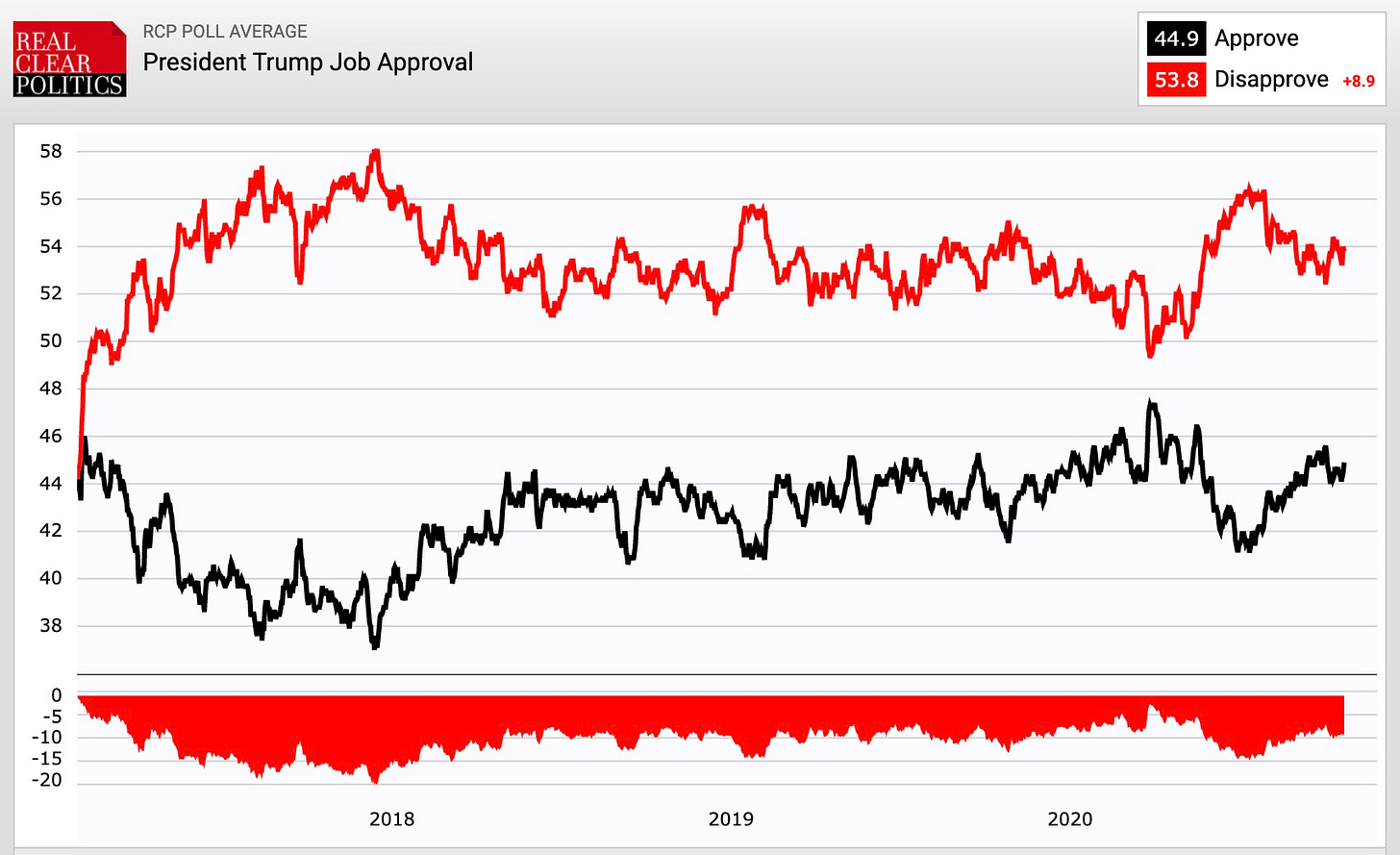
So what would you expect the national numbers to look like for a president who began his term with 46 percent of the vote and was then substantially net-negative on job approval for four years? You would expect his national support to be lower than 46 percent.
Presto.
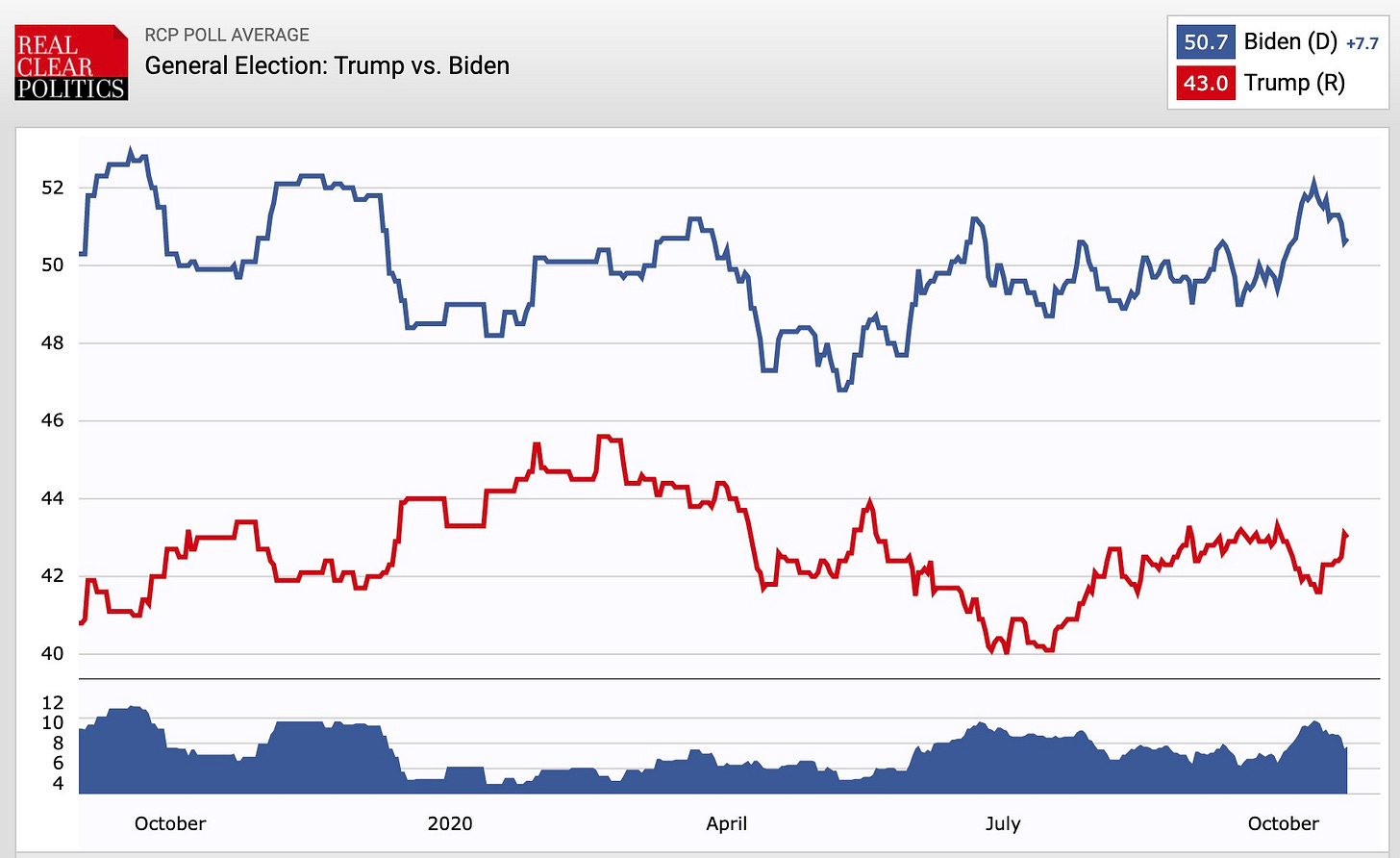
Now, if Trump’s national average has dropped, you would expect to see him losing ground with various demographic groups when you look at the cross tabs.
In 2016 Trump was +7 with voters over 65 and -13 with women. No matter what poll you look at, Trump has declined with both. Pew has him at ±0 with seniors and -16 with women. Pew’s poll is n=10,543 so it’s a pretty good sample, but you see this trend basically everywhere. Trump has gone backwards with seniors and women (among other groups) and hasn’t really gained appreciably with anyone aside from Hispanic males.
So if Trump’s national numbers are down and his numbers with many demographic groups are down, then we’d expect to see him losing ground in state polling, too.
Have a look:
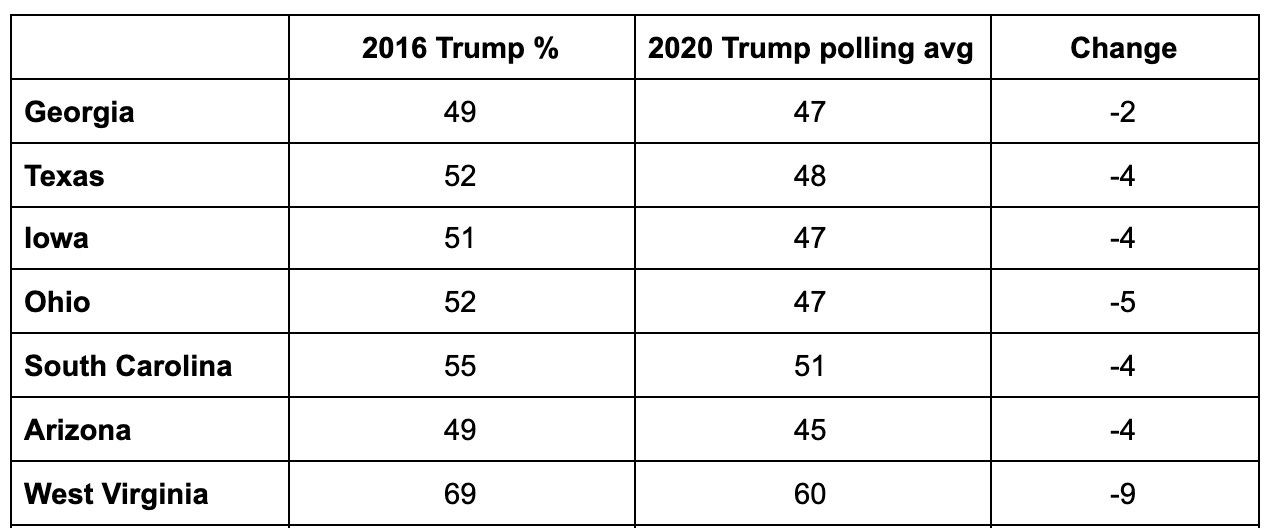
Note that none of these states are the big battlegrounds. We’re looking only at places Trump won comfortably in 2016 and that have, for the most part, very favorable demographics for him. And they’re exhibiting the same trends we see everywhere else: Trump’s position declining relative to 2016.
When you look at the battlegrounds, you see the same again:

By now you should sense a pattern. No matter which way you look at this race, Donald Trump is in a measurably worse position than he was in 2016.
The Trump people will tell you that all of these numbers are wrong. The polls are skewed. The samples are bad. There are shy Trump voters who don’t show up.
Maybe? But there is no actual evidence for any of that.
Ask yourself this: Is Trump showing a 9 point decline in West Virginia because of all the shy Trump voters down in the hollers?
On the other hand, all of the available evidence collected over four years of survey work points in the exact same direction:
A president elected with a minority vote share spent four years being deeply unpopular, lost ground across most demographic groups, and is now on track to finish with an even smaller vote share, both in states he won in 2016 and states he lost.
It’s not that complicated.
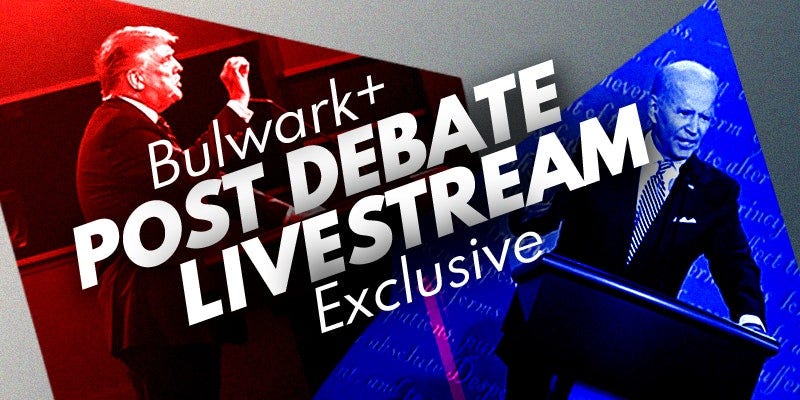
2. The Vegas Odds
What is complicated is translating that simple state of the race into outcome probabilities.
I like FiveThirtyEight’s big election model because it talks in probabilistic terms, which is the only sensible way to think about elections. Currently Nate & Co. have Trump’s chances of victory at 12 percent.
That sounds about right to me.
As of right now, I’d put the possible outcomes in this descending order of likelihood:
(1) Biden +7/+8. This would be a large victory on par with Obama’s 2008 win. Would probably be enough to carry the Senate, but would be right on the edge of what we think about as realignment. 7 in 20
(2) Biden +5/+6. It would mean that in the final days the race snapped back to its steady-state. Republicans probably keep a one-seat majority in the Senate. Both Democrats and Republicans have challenges in holding their coalitions together going forward. 5 in 20
(3) Biden ≥ +9. This is the big one. Absolute tsunami as the bottom drops out on Trump and Republicans everywhere. A realigning election that turns the GOP into a rump party for (at least) two years. 5 in 20
(4) Trump ≥ -3/-4. In this scenario Trump surges at the last minute, still finishes worse than in 2016, but gets incredibly lucky in picking off just enough states by five-digit vote margins that he gets to 270. 2 in 20
(5) Biden ≤ +3. Biden collapses from where he is now, but wins the close states that Clinton coin-flipped in 2016. 1 in 20
3. How to Manage a Team
It’s not an accident that lots of good sports teams are the product of smart corporate cultures. From the Athletic:
The Rays’ success, however, goes beyond mastery of analytics. Those familiar with the organization describe a culture that distinguishes itself for being free from turf wars and internal politics. Subordinates feel empowered to speak their minds, even if they disagree with their superiors. There is room to fail, which underpins their success. It begins at the top. This week, general manager Erik Neander cited a favorite saying of owner Stuart Sternberg: “Break a window, don’t burn down the house.”
It has been one of the central tenets of a culture that the Rays have spent years trying to build and maintain.
“It doesn’t happen overnight,” Neander said. “We screw up a lot. But we adjust. We’re OK making mistakes.” . . .
Still, the Rays continue to flourish, shaped by what Neander called an emphasis on “growing and cultivating people to step up into greater roles.” The effort has been intentional. Working in sports can be cutthroat, creating an environment where it’s far easier to lay low. In many places, the best way toward advancement is to simply say nothing. The Rays seek to work toward the opposite.
“We talk about activating our workforce, making sure that the people that we have working here develop enough comfort and feeling of security that they’ll speak up, that they’ll share their thoughts, that they’ll be willing to put themselves out there without fear of the consequences of being wrong or being off the mark,” said Neander, who began with the Rays in 2007 as an intern.
Clearing the way for fresh ideas has helped turn weaknesses into strengths. Consider how the team leveraged its oft-discussed locale. The franchise has been trying to secure a new ballpark seemingly since they came into existence. Tropicana Field is gray and dreary and cursed with catwalks. It sits in St. Petersburg, across the bridge from its core customers in Tampa, who must battle traffic for the privilege of watching a team devoid of stars within a venue with little charm. It’s not ideal — except that it creates an environment for experimentation without intense scrutiny.
As a result, the Trop has for years functioned as baseball’s living laboratory. Analytics were adopted early, which spurred on innovations such as defensive shifts, maximizing platoon advantages, and perhaps the Rays’ most famous innovation, the opener. All of it could be tried without the level of pushback that might be found elsewhere. . . .
“It’s incredibly empowering to have a culture where people are comfortable making mistakes and appreciating what can be gained by learning,” Neander said. “And really just focusing on trying new things, trying what we think is best, and putting ourselves out there. The ‘try’ is the most important part. Whether it’s successful or whether it fails, there’s so much to be gained either way just by the attempt to do whatever it is that you think we need to do.”


